Apple iPad mini with Retina Display: Reviewed
by Anand Lal Shimpi on November 16, 2013 8:00 AM ESTThe SoC
The iPad mini with Retina Display rounds out the three platforms that use Apple’s A7 SoC. Although both the iPad Air and iPhone 5S use the A7, the mini’s implementation is closer in nature to the iPhone. The iPad mini’s SoC has always used the same package-on-package (PoP) assembly as the iPhone, with DRAM stacked on top of the SoC itself (1GB in this case). The benefit is obviously a reduction in board area, the downsides have to do with cost and thermals. That’s the first similarity between the mini’s A7 and the iPhone’s A7.
The second is one of frequencies. While the iPad Air’s A7 runs its two Cyclone CPU cores at up to 1.4GHz, the SoC in the iPad mini and the iPhone 5S runs at up to 1.3GHz. That might sound like a minor difference, but it’s far more pronounced when you look at what happens to frequency when you’re running heavy workloads.
Once again I turn to a fairly heavy CPU workload to plot performance over time. This is a multithreaded workload, slightly modified from what we used in the iPad Air review, designed to make the CPU cores consume max power. The scale is linear and the workload is the same across all devices, so what you’re effectively looking at is a graph of thermally bound CPU performance over time across all three A7 implementations:
Being the largest device (and the only device with a metal heat spreader and no DRAM stacked on top), the iPad Air obviously maintains the highest frequencies for the duration of the test. The iPhone 5S, with a significant reduction in internal volume (and a PoP SoC) reduces its CPU frequencies early on in order to keep skin temperature down and properly manage thermals. The iPad mini with Retina Display falls between the two, with its performance curve more closely following that of the iPhone 5S.
Although the mini has a similar max operating frequency to the iPhone 5S, it is a faster device thanks to it being less thermally constrained. Similarly, the iPad Air can be much faster than its clock speed would otherwise imply. If you’re wondering why Apple has been so focused on building its own SoCs and CPU architectures, this is the reason why. There’s a fixed amount of power you can dissipate in the form of heat in these mobile devices while still maintaining a good user experience. Performance per watt is the gating metric for success in mobile, and shipping high IPC/low frequency dual-core SoCs at 32/28nm is the best optimization available to a company like Apple today.
As you’d expect, our browser based CPU tests show the mini’s A7 performing in between the iPhone 5S and iPad Air. None of these tests are anywhere near as stressful as our thermal test from above, so we don’t see exaggerated differences in performance between the platforms. For most, I suspect you won’t notice a huge performance difference between the mini and Air. Those who are heavier users (e.g. audio mixing, 3D gaming, etc…), there will be a performance difference between the two iPads.
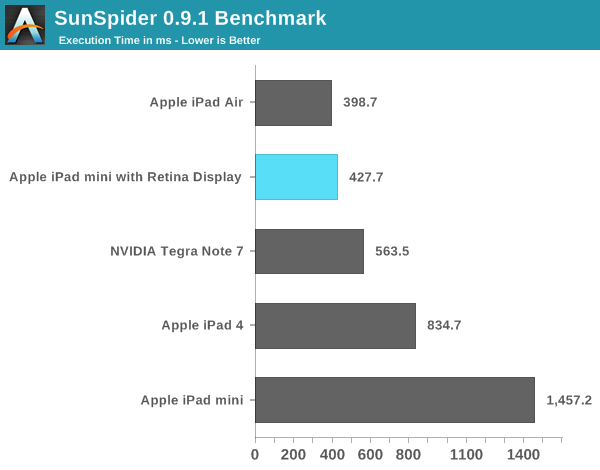

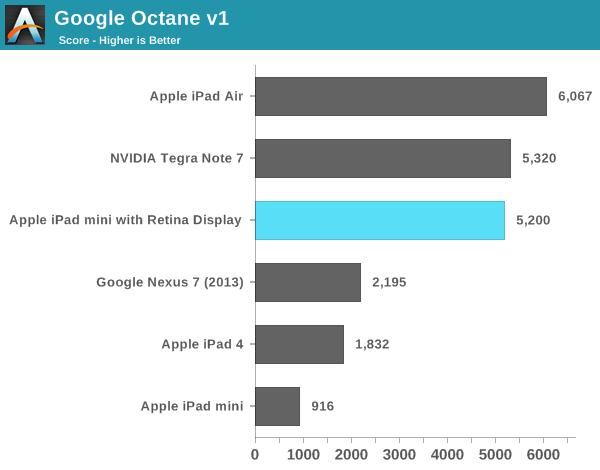
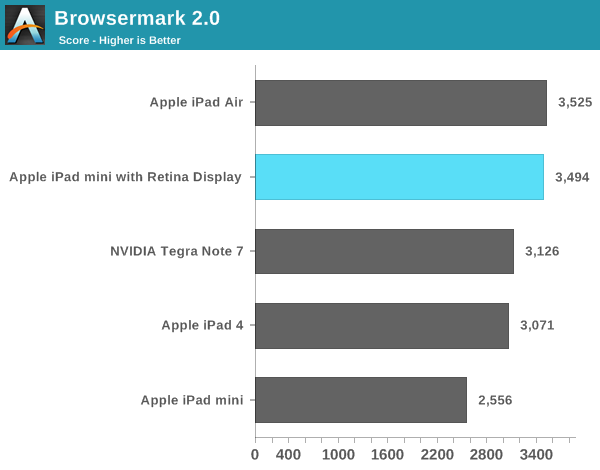
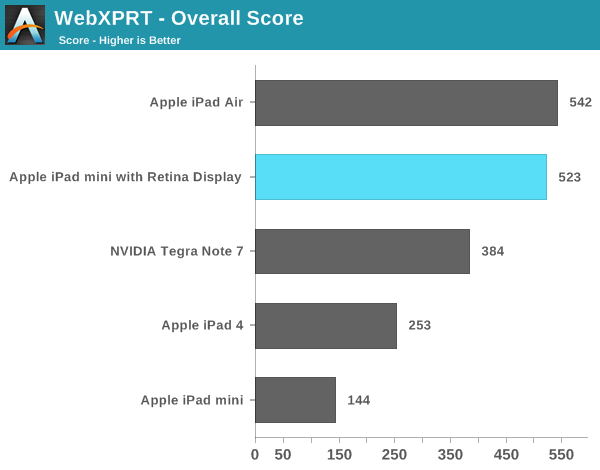
Compared to the first generation iPad mini, the new model is in a completely different performance league. Keep in mind the first mini used Apple’s A5 SoC based on an ARM Cortex A9. That’s the same single threaded performance as what’s in an iPhone 4S, and under iOS 7 it’s clearly running into some performance limits. The new mini with Retina Display however is a completely different animal. It’s fast.
Even comparing to the 4th generation iPad, the new mini is noticeably quicker.
Memory Bandwidth
Looking at the iPad mini’s memory bandwidth curve, we see it tracks very closely with that of the iPhone 5S. This is a slightly modified version of our previous bandwidth test, and you can see peak usable memory bandwidth (from the CPU’s perspective) of around 10GB/s. The ~12GB/s area right before you get out to main memory is bandwidth to the A7’s 4MB system-wide cache that sits after the shared L2 and the memory controller. This cache appears to service CPU, GPU and ISP requests at least.
GPU Performance
I believe the A7’s PowerVR G6430 GPU runs at around 450MHz. This frequency appears unchanged across all three A7 implementations. Once again, the big difference is how much thermal headroom exists in the platform which has an impact on overall performance.
Kishonti’s low level GPU performance tests back up my assertion that GPU frequency is fixed across all A7s. The iPad mini with Retina Display delivers equal performance to the iPad Air. The bigger news here is that nearly all of the GPU bound 3D tests seems to peg the mini and Air as equals. These are some pretty intense tests, but it looks like on the GPU side there’s no significant throttling when running at full tilt.
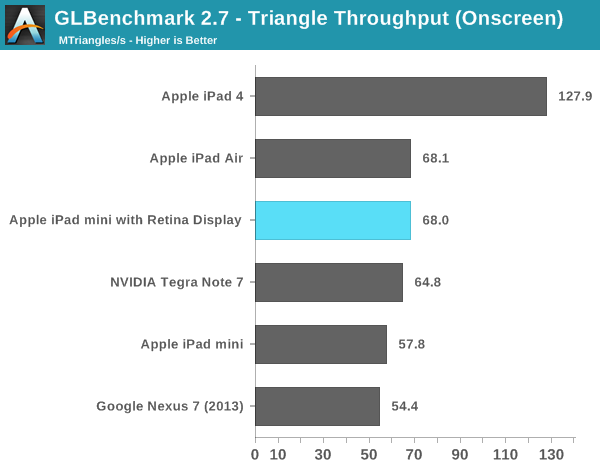

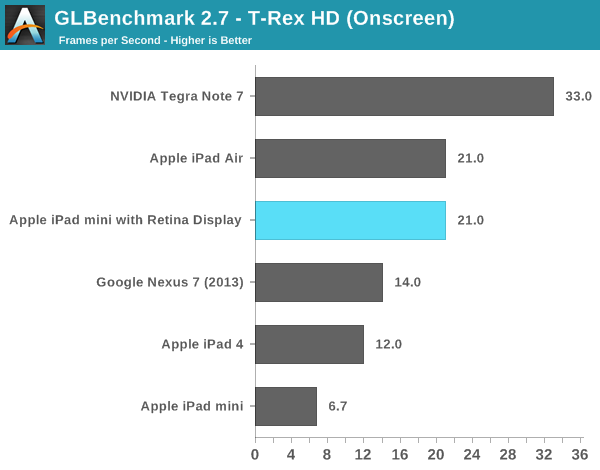

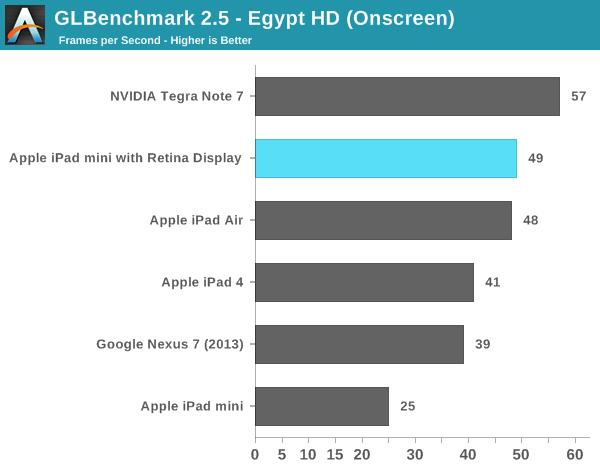
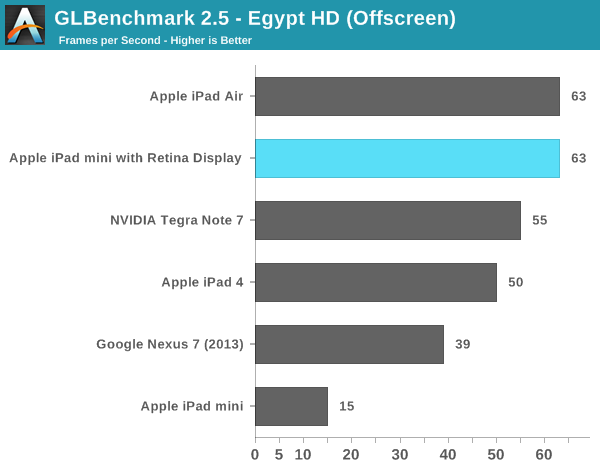
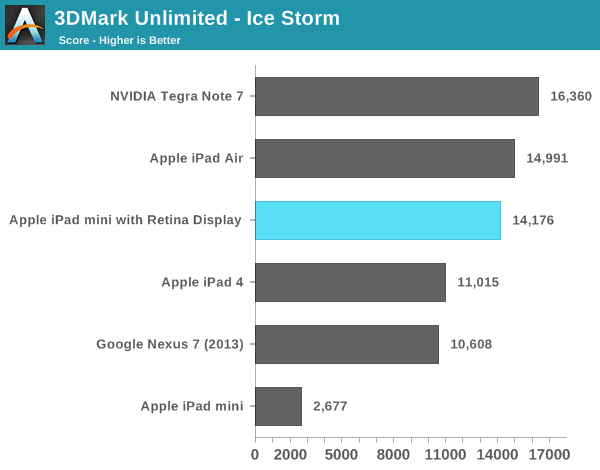
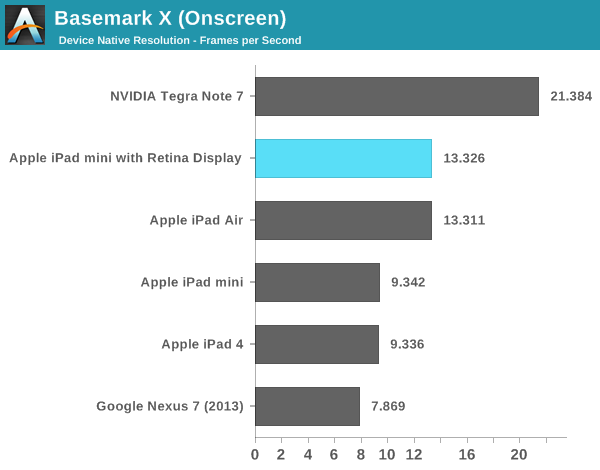
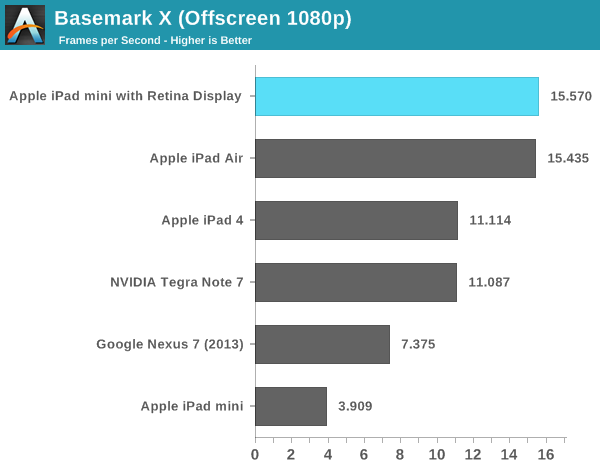
As I mentioned in our iPad Air review, despite having less peak theoretical memory bandwidth than the A5X/A6X, the A7 in the iPad mini never seems to regress in performance compared to even the iPad 4. Across the board the mini appears to be faster, more responsive and have more performance on tap than any prior iPad (big or small). The comparison to the original iPad mini is of course night and day. Even looking at lighter tests like the old GLBench Egypt HD benchmark, the iPad mini with Retina Display manages to be nearly twice as fast as the original mini - all while rendering 4x the number of pixels.


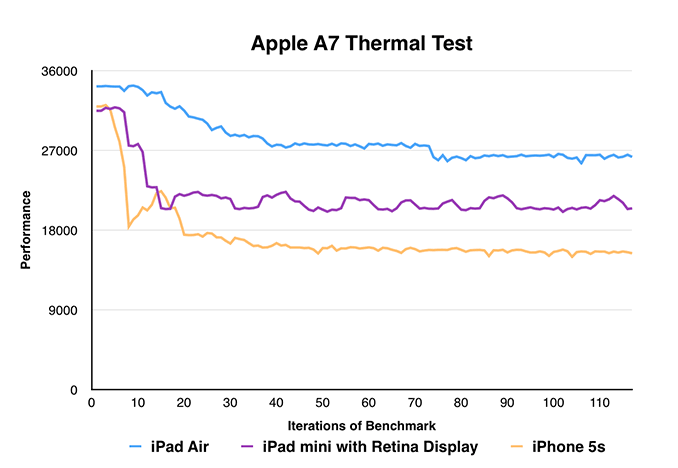
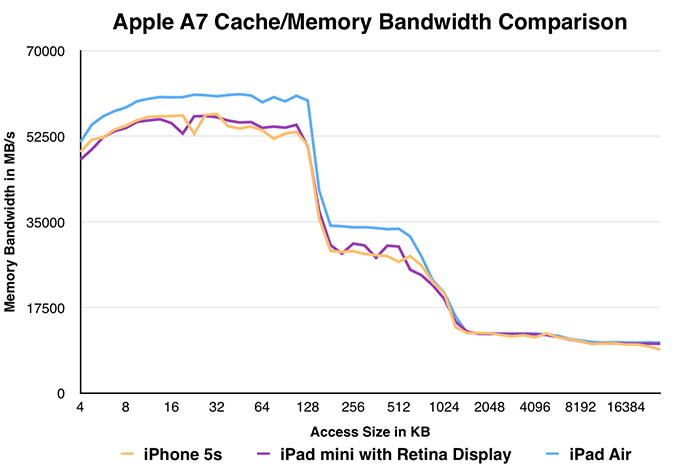








345 Comments
View All Comments
MarcSP - Sunday, November 17, 2013 - link
Surface is not x86. I don't understand why the CPU architecture is important for the common user. I think the overall experience is what they mind. And, anyway, latest x86 SoC are as good or better than ARM counterparts in performance and power consumption.zeagus - Monday, November 18, 2013 - link
Competitive, not as good or better. The A7 and even IIRC SnapDragon 8xx beats the latest x86 mobile SoC from Intel.MarcSP - Monday, November 18, 2013 - link
Ok, but my point is still valid, that x86 or ARM is barely something relevant when choosing one device (being other factors, such as the OS, the same or similar).ananduser - Sunday, November 17, 2013 - link
The Verge also noticed performance issues, stuttering and lag.socio-statistical - Monday, November 18, 2013 - link
Good luck getting an Android user to admit even that their device is an outright copy of the iPad (which literally everyone else can see) let alone that anyone would consider buying the iPad it so obviously copies. At least MSFT finally produced a not-totally-cribbed from Apple device. (If we can at this point consider Windows to be anything remotely 'new' or original that is.)MrX8503 - Saturday, November 16, 2013 - link
Srry KPOM. Meant to reply to BPB.BPB - Saturday, November 16, 2013 - link
The day this site recommends an Android or Windows device over the competing Apple product I will reconsider. My point is that in the end every article/review here leans Apple when Apple is involved. Heck, the phone guy doesn't even do Windows Phone devices and openly mocks them. At the end of the day they will give the Apple competitors some praise, but they don't recommend the competitors over Apple.Check out the Nexus 7 conclusion:
"The original Nexus 7 gave us a decent Android experience at a very low cost. This year ASUS and Google raised the bar for sure. The new Nexus 7 is no longer just a decent tablet at a good price, it's an incredible tablet. With this Nexus, it's clear that Google no longer wants to rely on value alone. The 2013 Nexus 7 redefines what you should expect to pay for a truly great tablet. If you're in the market for an ultra portable tablet, and definitely if you're shopping for an Android tablet in particular, the new Nexus 7 should be at the top of your list. It's so good that I'm giving it our Silver Award."
An "incredible" and "truly great" tablet at a good price gets a silver award, not gold. What does it take to get gold? Possibly, just possibly, a company name that is a fruit.
chaosbloodterfly - Saturday, November 16, 2013 - link
The only gold award given to a smartphone was to the HTC One, a decidedly not fruity company. Anandtech also doesn't give out awards lightly. There isn't even an award in this review. Or the 5s review. Stop grasping at straws here.KPOM - Saturday, November 16, 2013 - link
I don't believe Anand has ever actually awarded an Apple product a gold award (at least not recently).BPB - Saturday, November 16, 2013 - link
By the way, I in no way deny the fact that Apple makes good stuff. My best friend and my brother use their products, and they are not fools.I didn't realize I accidently deleted the following from my previous comment:
"Yes, Apple doesn't get an award here, nor do I see any in other reviews I found after a quick search. But I think I know why that is. In order to give out awards you need to have competition, here, at least, Apple has none."